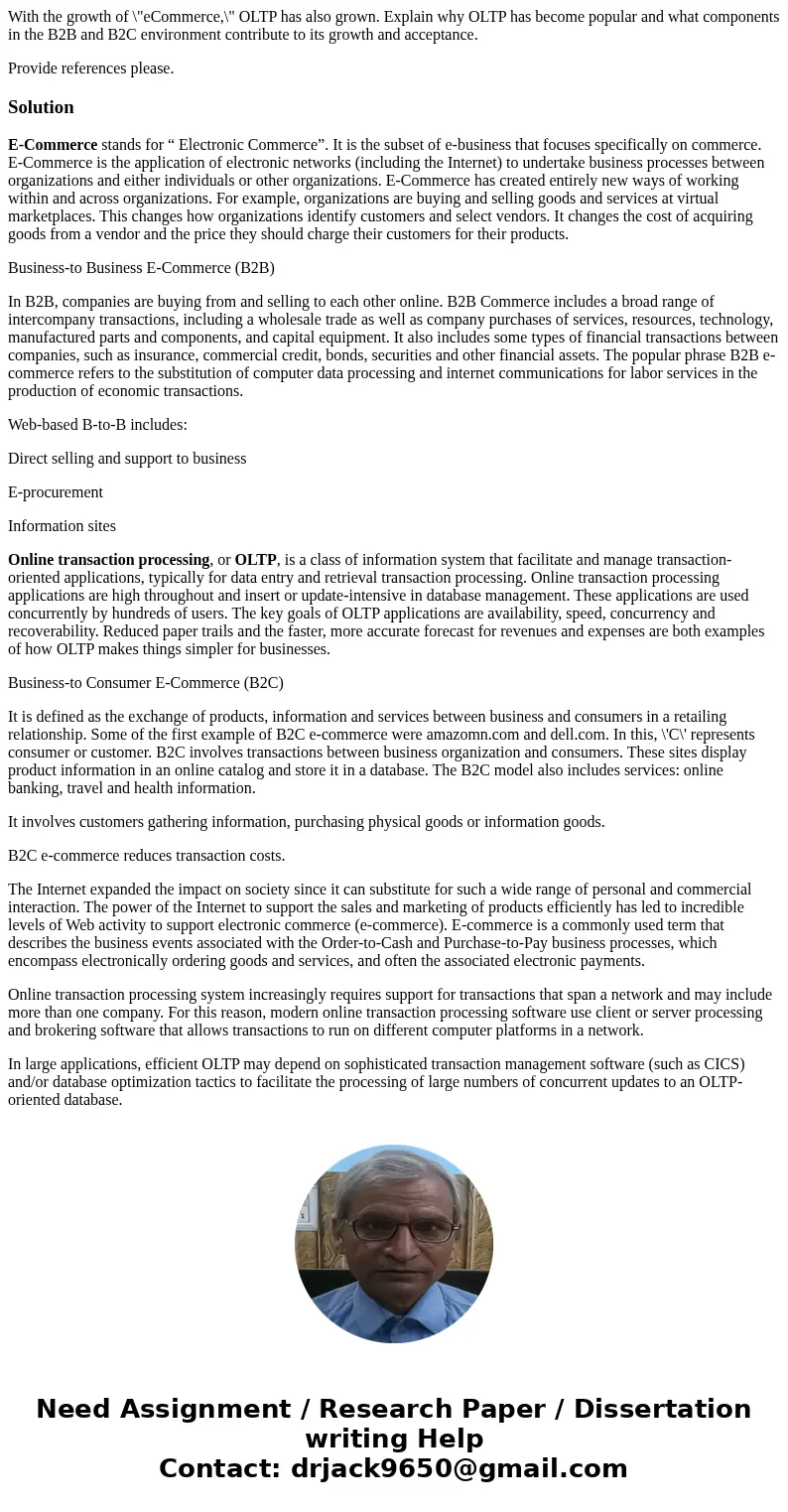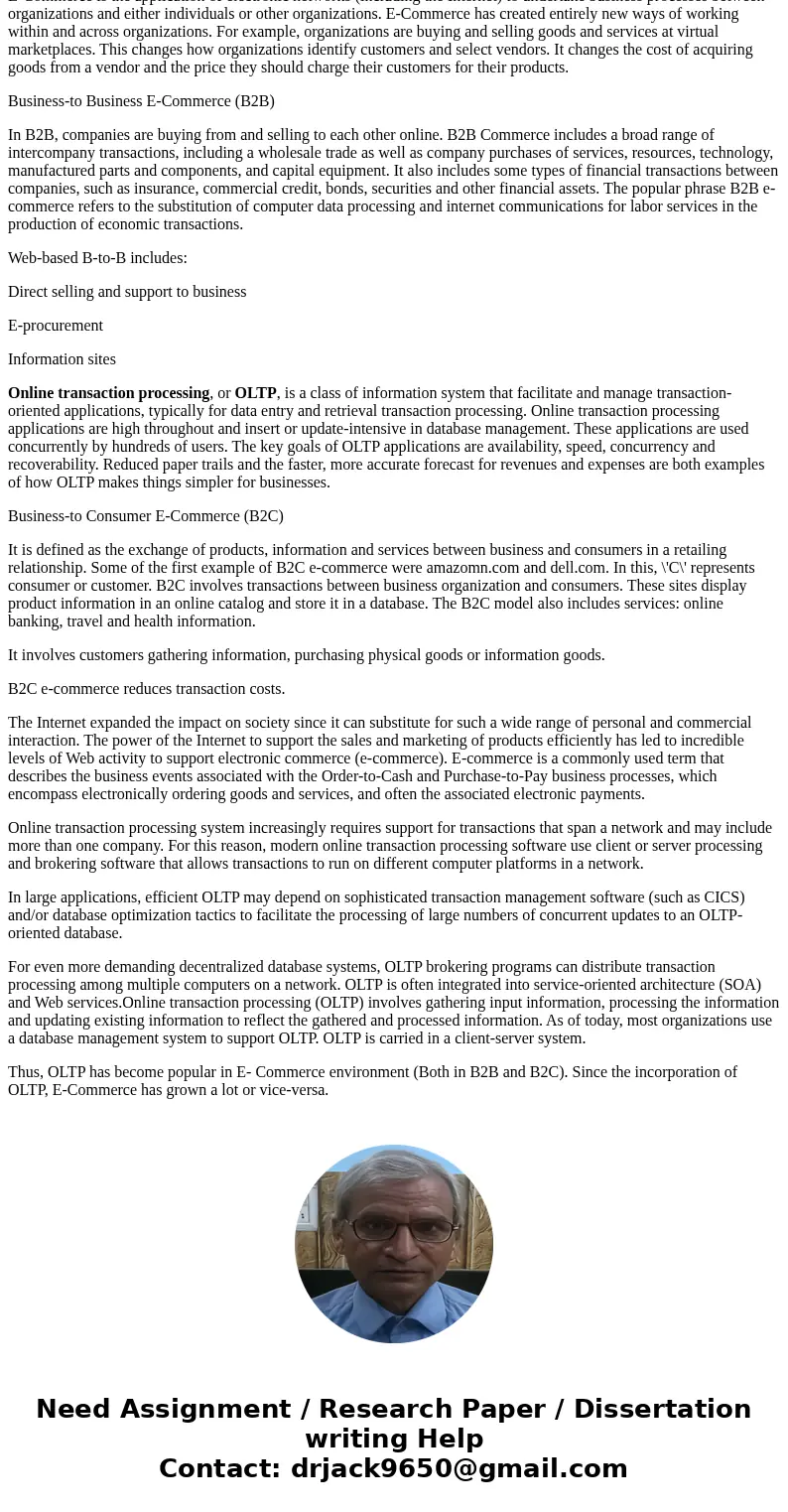With the growth of eCommerce OLTP has also grown Explain why
With the growth of \"eCommerce,\" OLTP has also grown. Explain why OLTP has become popular and what components in the B2B and B2C environment contribute to its growth and acceptance.
Provide references please.
Solution
E-Commerce stands for “ Electronic Commerce”. It is the subset of e-business that focuses specifically on commerce. E-Commerce is the application of electronic networks (including the Internet) to undertake business processes between organizations and either individuals or other organizations. E-Commerce has created entirely new ways of working within and across organizations. For example, organizations are buying and selling goods and services at virtual marketplaces. This changes how organizations identify customers and select vendors. It changes the cost of acquiring goods from a vendor and the price they should charge their customers for their products.
Business-to Business E-Commerce (B2B)
In B2B, companies are buying from and selling to each other online. B2B Commerce includes a broad range of intercompany transactions, including a wholesale trade as well as company purchases of services, resources, technology, manufactured parts and components, and capital equipment. It also includes some types of financial transactions between companies, such as insurance, commercial credit, bonds, securities and other financial assets. The popular phrase B2B e-commerce refers to the substitution of computer data processing and internet communications for labor services in the production of economic transactions.
Web-based B-to-B includes:
Direct selling and support to business
E-procurement
Information sites
Online transaction processing, or OLTP, is a class of information system that facilitate and manage transaction-oriented applications, typically for data entry and retrieval transaction processing. Online transaction processing applications are high throughout and insert or update-intensive in database management. These applications are used concurrently by hundreds of users. The key goals of OLTP applications are availability, speed, concurrency and recoverability. Reduced paper trails and the faster, more accurate forecast for revenues and expenses are both examples of how OLTP makes things simpler for businesses.
Business-to Consumer E-Commerce (B2C)
It is defined as the exchange of products, information and services between business and consumers in a retailing relationship. Some of the first example of B2C e-commerce were amazomn.com and dell.com. In this, \'C\' represents consumer or customer. B2C involves transactions between business organization and consumers. These sites display product information in an online catalog and store it in a database. The B2C model also includes services: online banking, travel and health information.
It involves customers gathering information, purchasing physical goods or information goods.
B2C e-commerce reduces transaction costs.
The Internet expanded the impact on society since it can substitute for such a wide range of personal and commercial interaction. The power of the Internet to support the sales and marketing of products efficiently has led to incredible levels of Web activity to support electronic commerce (e-commerce). E-commerce is a commonly used term that describes the business events associated with the Order-to-Cash and Purchase-to-Pay business processes, which encompass electronically ordering goods and services, and often the associated electronic payments.
Online transaction processing system increasingly requires support for transactions that span a network and may include more than one company. For this reason, modern online transaction processing software use client or server processing and brokering software that allows transactions to run on different computer platforms in a network.
In large applications, efficient OLTP may depend on sophisticated transaction management software (such as CICS) and/or database optimization tactics to facilitate the processing of large numbers of concurrent updates to an OLTP-oriented database.
For even more demanding decentralized database systems, OLTP brokering programs can distribute transaction processing among multiple computers on a network. OLTP is often integrated into service-oriented architecture (SOA) and Web services.Online transaction processing (OLTP) involves gathering input information, processing the information and updating existing information to reflect the gathered and processed information. As of today, most organizations use a database management system to support OLTP. OLTP is carried in a client-server system.
Thus, OLTP has become popular in E- Commerce environment (Both in B2B and B2C). Since the incorporation of OLTP, E-Commerce has grown a lot or vice-versa.


 Homework Sourse
Homework Sourse